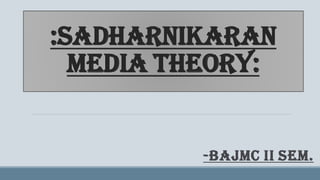
The Indian Media Theory: Communication Theory of Sadharnikaran
- 2. “Sadharanikaran” “Sadharanikaran”, meaning “simplification without dilution”, represents a communication tradition that includes simplification, rasa (emotion), sahridaya (compassion with affection), a symmetry (hierarchy) and social universalization. It explicates the relational and social processes of communication as opposed to individual constructs. It articulates emotion and collective social change as central responses to communication. An empirical application of Sadharanikaran to promoting handwashing with soap after defecation in rural Maharashtra, India is discussed. The challenge is how to bring about social health behavior change with communication interventions that are both socio-culturally meaningful and persuasively powerful. The relevance of Sadharanikaran to local and global contexts is outlined.
- 4. Sadharanikaran Model of Communication – Sadharanikaran model of communication (SMC), was proposed by Dr. Nirmala Mani Adhikari on 2003. It illustrates how the communication parties interact in a system for the attainment of commonness or oneness. Sahridayata and Sahridayas are the core concepts upon which the meaning of sadharanikaran resides. The sender and receiver attain sahridayata or become sahridayas only when they accomplish the process of sadharanikaran. Sadharanikaran is rooted in Natyashastra of Bharata. Scholars widely believe that Bhattanayaka introduced the concept of sadharanikaran. He is credited for the use of the term in his commentary on Natyashastra to explain the concept of rasa. Sadharanikaran word is derived from the Sanskrit word sadharan; which means ‘commonality’ or ‘simplification’ in English.
- 5. Dr. Nirmala Mani Adhikari proposed Sadharanikaran model of communication.
- 6. “Elements of Sadharnikaran Model of Communication" Elements Sahridayas (Preshaka, i.e. sender and Prapaka, i.e. receiver) Bhava (Moods or emotions) Abhivyanjana (Expression or encoding) Sandesh (Message or information) Sarani (Channel) Rasaswadana (Firstly receiving, decoding and interpreting the messageand finally achieving the rasa) Doshas (Noises) Sandarbha (Context) Pratikriya (Processof feedback)
- 7. Sahridayas are the people with a capacity to send and receive messages. They are the parties engaged in communication, and capable of identifying each other as sender and receiver of the process. If communication Is taken as a step-by-step process, which is just for the sake of easy understanding, the sahridaya-preshaka (sender). In the communication process; the complex concepts and ideas are simplified by the speaker(source) with illustrations and idioms appropriate for the understanding of the listener (receiver of the message). Bhavas are manifested as sandesha. The channels may be natural such as auditory, tactile, visual, olfactory and taste channels.
- 8. Rasaswadana is the receiving of the message by the receivers, decoding it and finally enjoying the rasa of the sandesha. Doshas are those noises which distort the message and leads to miscommunication. Sandarbha is context and the effectiveness of any message depends on the communication environment. Pratikriya refers to the responses of the receiver after receiving the message. It is the process of feedback, which allows the receiver to have active role in the communication process. **Sadharanikaran on the other hand is better suited for real world communication.**
- 9. Model of Sadharanikaran : It tells that the effectiveness of any message depends on the communication environment because same message may have different meaning in different contexts. Context is known as ‘sandarbha’ in Sadharanikaran model. It makes Hindu concept of communication even more comprehensive.
- 10. Fundamentals of Sadharanikaran : ➢ The structure of the model is non-linear. It incorporates the notion of two-way communication process resulting in mutual understanding of the communicating parties. ➢ The model illustrates how successful communication is possible in Hindu society where complex hierarchies of castes, languages, cultures and religious practices are prevalent. ➢ The inter-relationship between the communicating parties is of crucial importance in sadharanikaran. Here, not the cause of the relationship but the relationship itself is significant. ➢ And, unlike in case of most communication theories and models from the West, this does not emphasize on dominance by the sender. Rather, the model gives equal importance to both the communicating parties.
- 11. ➢ The model shows that abhivyanjana (encoding) and rasaswadana (decoding) are the fundamental activities in communication. ➢ It shows that Hindu perspective on communication emphasizes more on internal or intrapersonal activity. For instance, both the processes of encoding and decoding consits of four-layer mechanism in its ideal form. ➢With the provision of sandarbha (context), the model clarifies how meaning could be provided to the message even if the sender is not identified to the receiver. Thus due to the context a text can retain its ‘objective’ meaning.
- 12. Conclusion: The meta-theoretical assumption of the model is Vedantic. Hindu way of communicating certainly emphasizes on internal or intrapersonal activity. It is comprehensible that abhivyanjana and rasaswadana are the fundamental activities in communication, and in Hindu life communication involves more experience within than objective rationality of the sensory organs. This tendency facilitates sahridayata and other concepts to be materialized practically. Thus, communication results in communion in Hindu society.